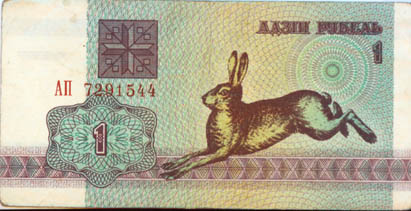
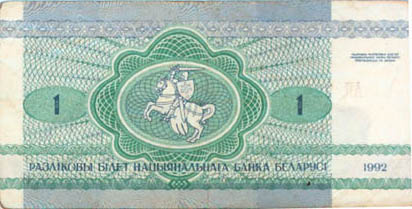
Money
& Prices in Belarus



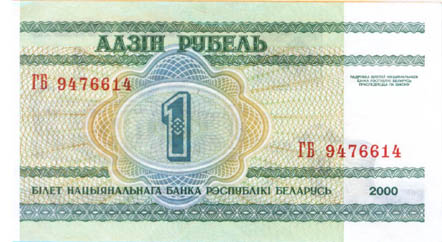
* I can't guarantee that their information is absolutely accurate and up-to-date, but it seems reasonable. Currently the market rate is close to the official exchange rate of National Bank. I am showing below the commercial (black market) conversion rates not the official rate of National Bank. In some years they were coinciding like now (Feb. 2001), but in some years (1997-2000) the official rate of exchange was lower than market rate, and black market hard currency speculation existed.
| Date | $1 US equals | Source of the info | Comments |
| Apr. 16,95 | 11, 700 BR |
private | BR - Belarusian Ruble |
| Aug. 22, 95 | 11, 500 BR |
BISNIS | |
| Nov. 10, 95 | 11, 700 BR |
private | |
| May 4, 96 | 12, 400 BR |
OMRI | |
| Oct. 6, 96 | 16, 000 BR |
private | |
| Feb. 15, 97 | 22, 380 BR |
private | |
| May 17, 97 | 27, 000 BR |
been there myself | |
| Jan. 1, 98 | 42, 000 BR |
private | |
| Aug. 1, 98 | 60, 000 BR |
private (approximately) | |
| Sep. 1, 98 | 90, 000 BR |
private (approximately) | Up 50% after Russian ruble collapse. |
| Jan.1, 99 | 255, 000 BR |
Belmoney | |
| Feb. 1, 99 | 290, 000 BR |
Belmoney | |
| Mar. 1, 99 | 400, 000 BR |
Belmoney | |
| Apr. 1, 99 | 405, 000 BR |
Belmoney | |
| Jun. 21, 99 | 440, 000 BR |
Belmoney | |
| Sep. 1, 99 | 505, 000 BR |
Belmoney | |
| Oct. 1, 99 | 520, 000 BR |
Belmoney | |
| Oct. 11, 99 | 540, 000 BR |
Belmoney | |
| Oct. 19, 99 | 625, 000 BR |
Belmoney | |
| Nov 1, 99 | 700, 000 BR |
Belmoney | |
| Nov. 12, 99 | 740, 000 BR |
Belmoney | |
| Jan. 27, 00 | 890 NBR |
Belmoney | Denomination 1000 BR = 1 NBR |
| Feb. 27, 00 | 905 NBR |
Belmoney | NBR - New Belarusian Ruble |
| Mar. 27, 00 | 920 NBR |
Belmoney | |
| Jun.. 16. 00 | 979 NBR |
Eco Press Informational | |
| Oct. 13, 00 | 1,048 NBR |
Eco Press Informational | |
| Feb. 21, 01 | 1,238 NBR |
Eco Press Informational | |
| May 4, 01 | 1,335 NBR |
Eco Press Informational | |

The graph is shown in Old Belarusian Rubles - 1000 Old BR = 1 New BR. There was a big hyperinflation jump in 1991-1992. BR was stable for more than a year in 1995-96 and then started to rise. This seems to be a usual thing that happens to money after hyperinflation jump. The same dynamics was with Polish zloty, the same stuff happened to Russian ruble. The first kink in slope on August 1998 was a result of Russian Ruble collapse. This Russian crisis sent aftershock all over the world. I'm not sure about the origin of the next two kinks in March 99 and October 99. It could be related to Russian ruble again. I'd appreciate your comments on this.
Right now the official value of BR is some 50% lower than the black market one. President Lukashenka is trying to hold the value of BR with laws against currency "speculation". And so there is a deficit of hard currency.
An interesting analysis of economics in Eastern Europe is made by NATO Economic Colloquium.
Prices in Belarus
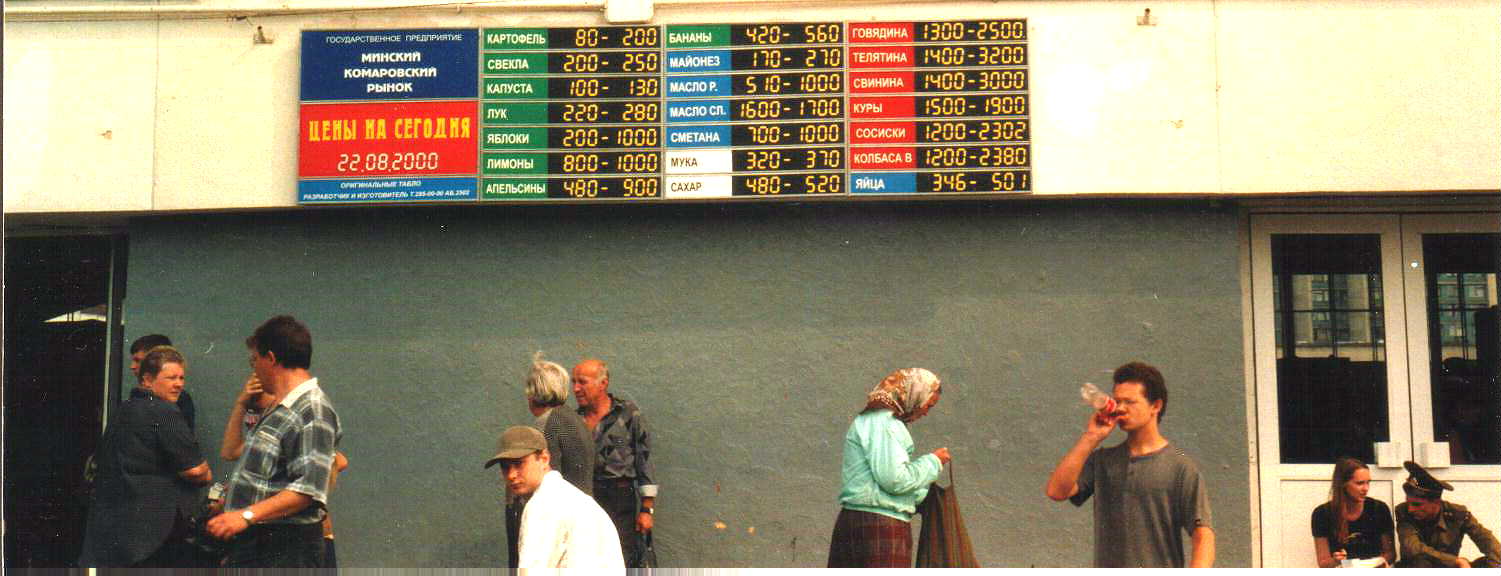
Some Basic Food Prices
August 22, 2000 Kamarouski market, Minsk.
1 US Dollar = 994 New BR
1 kg of bread = 170 New BR
1 kg of potatoes = 80 - 200 New BR
1 kg of beets = 200 - 250 New BR
1 kg of cabbage = 100 - 130 New BR
1 kg of onions = 220 - 280 New BR
1 kg of apples = 200 - 1000 New BR
1 kg of lemons = 800 - 1000 New BR
1 kg of oranges = 480 - 900 New BR
1 kg of bananas = 420 - 560 New BR
1 L of mayonese = 170 - 270 New BR
1 L of vegetable oil = 510 - 1000 New BR
1 kg of butter = 1600 - 1700 New BR
1 L of sour cream = 700 - 1000 New BR
1 kg of wheat flower = 320 - 370 New BR
1 kg of sugar = 480 - 520 New BR
1 kg of beef meat = 1300 - 2500 New BR
1 kg of pork meat = 1400 - 3000 New BR
1 kg of chicken = 1500 - 1900 New BR
1 kg of sausage = 1200 - 2380 New BR
10 eggs = 346 - 501 New BR
January 2000 - There was a 1/1000 denomination of Belarusian Ruble: 1000 BR = 1 New BR.
February 15, 97: Hrodna, Belarus
1 kg of bread = 4,600-6,000 BR
1 L of milk = 4,600 BR
1 kg of meat (pork) = 34,000 BR
November 10,95. Hrodna, Belarus
1 kg of bread = 2,100 BR
1L of milk = 2,400 BR
1 kg of meat (pork) = 31,000 BR
February 20,95. Hrodna, Belarus
1 kg of bread = 1,000 BR
1L of milk = 600 BR
1 kg of meat (pork) = 30,000 BR
Keep in mind that average monthly salary is around $80, and average pension for retired is about $40. President Lukashenka manages somehow to keep retired people above starving level. His methods are questionable, but it's easier to judge than to be in his place.
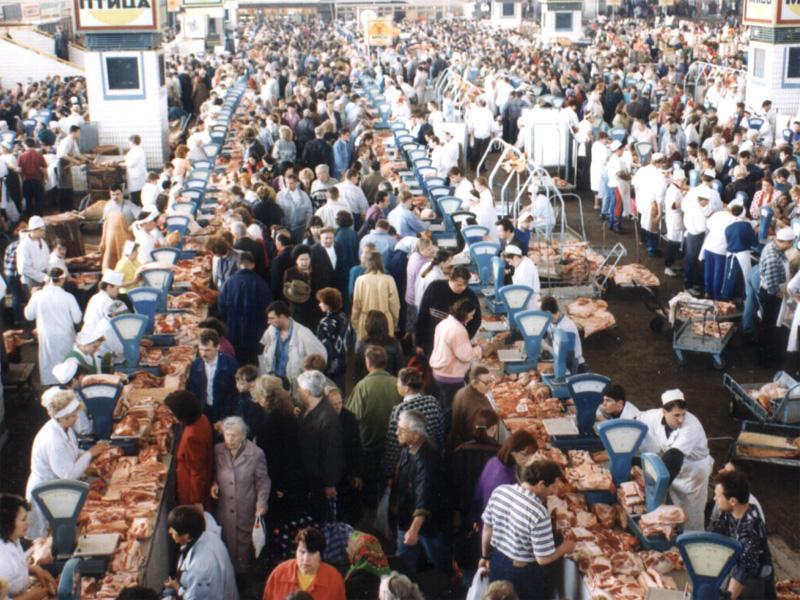
A shot of Kamarouski Meat Market by Carlo Morlacchi.
 This file is a part of the Virtual
Guide to Belarus - a collaborative project of Belarusian
scientists and professionals abroad. VG brings you the most extensive compilation
of the information about Belarus on the Web.
This file is a part of the Virtual
Guide to Belarus - a collaborative project of Belarusian
scientists and professionals abroad. VG brings you the most extensive compilation
of the information about Belarus on the Web.
Please send your comments to the authors of VG to
Belarus
History | Statehood | Culture | Law
and Politics | Cities | Nature and Geography |
©1994-04 VG to Belarus
Disclaimer